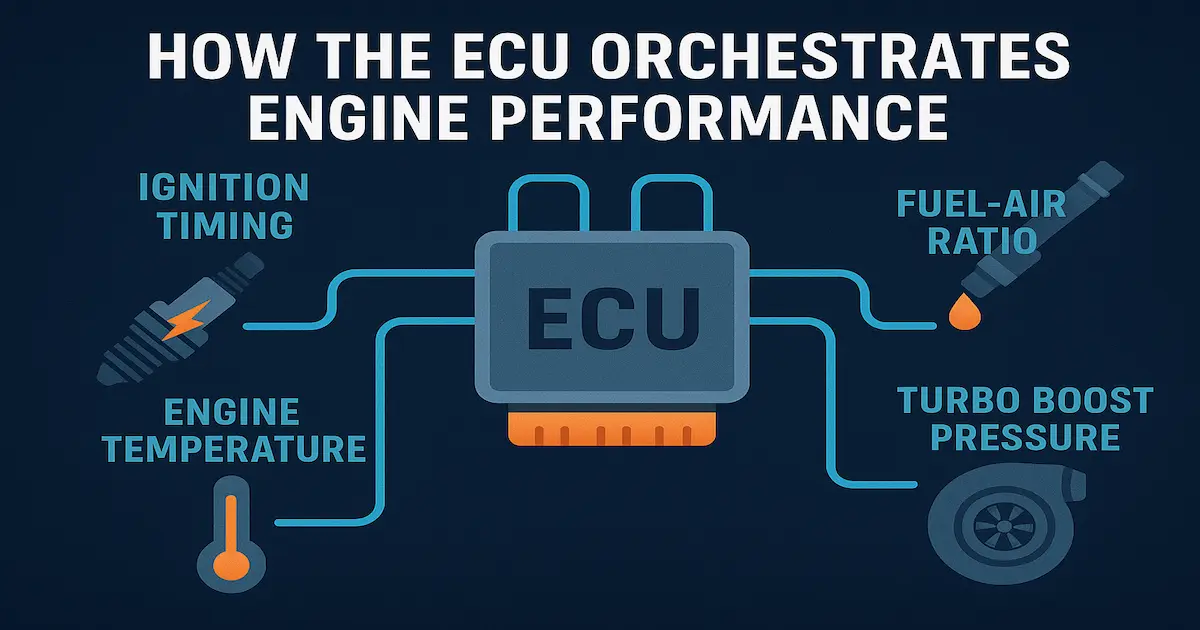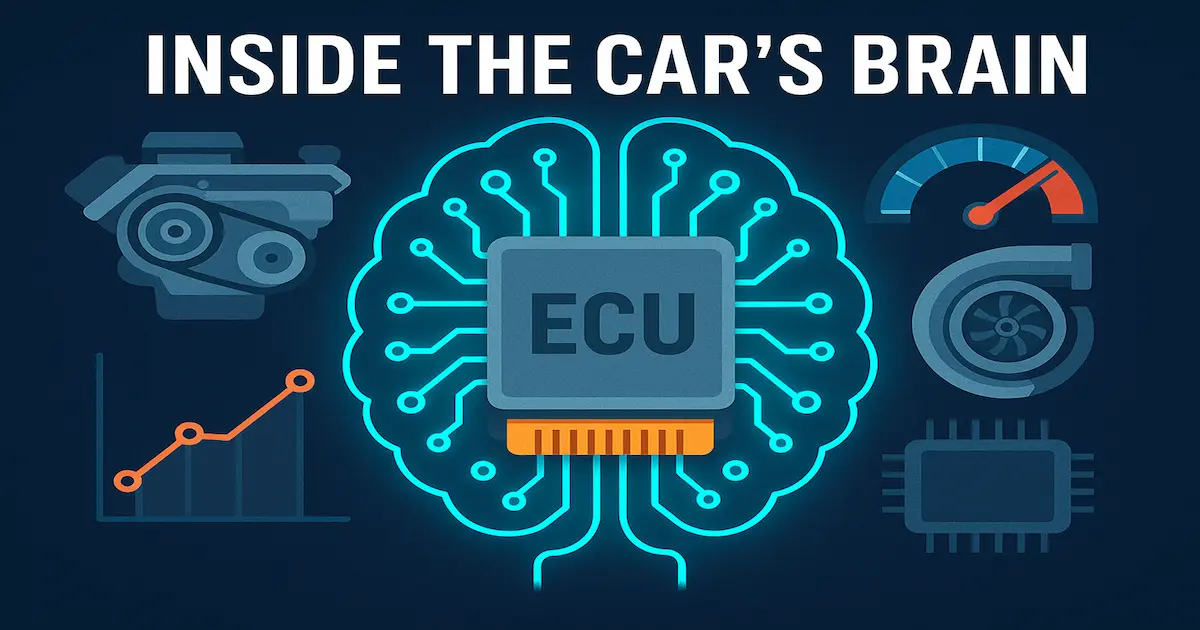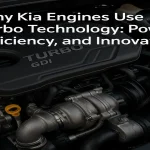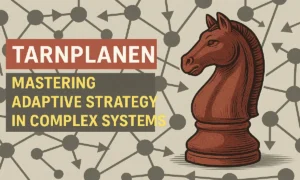Cars today are not only about pistons, gears, and fuel. They are intelligent systems that blend mechanics with advanced computing. At the heart of this transformation lies the Engine Control Unit (ECU), often described as the car’s brain.
Without this compact yet complex computer, modern driving as we know it would not exist. The ECU constantly manages everything from fuel injection to turbo boost pressure, coordinating hundreds of tasks at once.
Think of the ECU as a silent conductor guiding a massive orchestra. It takes signals from dozens of instruments—sensors, valves, and actuators—and makes sure they all play in harmony.
The ECU relies on pre-programmed instructions to control how the engine operates, balancing efficiency, performance, and safety. From the moment you turn the key, this unseen brain ensures the car runs smoothly no matter the conditions outside. Lets dive in!
How the ECU Orchestrates Engine Performance

Every second, your ECU handles thousands of calculations. It receives information about engine temperature, exhaust gases, throttle position, fuel-air ratio, and ignition timing.
Using lookup tables, it determines exactly how much fuel to inject, when to fire the spark plug, and how to control turbo boost pressure. All of this happens in milliseconds, creating a seamless driving experience.
Manufacturers, however, don’t unleash the full capability of the engine. Instead, they use parameters conservatively set to meet emissions laws and to guarantee reliability in every environment—from the freezing winters of Alaska to the deserts of Arizona.
Read More: The Best Cars Made Since 2015: A Modern Automotive Showcase
While these restrictions make vehicles globally reliable, they also leave hidden performance untapped. This is where enthusiasts often turn to ECU remapping to unlock the engine’s true personality.
Unlocking Potential Through ECU Tuning
ECU remapping is the process of altering the software inside the ECU to enhance vehicle performance. This practice, also known as software tuning, changes how the engine reacts to different conditions.
A skilled tuner can optimise how the engine responds under certain conditions, allowing sharper throttle, increased power, or better fuel efficiency.
The process is far more advanced than just flipping a switch. A tuning specialist connects through the diagnostic port, sometimes connecting through the diagnostic port with specialised software, or when necessary, having the ECU bench flashed directly.
By carefully rewriting the maps, they unlock horsepower and torque that manufacturers leave unused. Drivers in the USA often choose remapping for more towing power in trucks, sharper acceleration in sports cars, or better mileage in daily commuters.
Behind the Scenes: Tools and Data at Work
Tuning is a combination of science and art. Modern tuners rely on real-time data logging systems that monitor airflow, exhaust gas temperature, and boost levels. They don’t guess—every adjustment is measured.
By analyzing this live stream of information, specialists are building a custom map for each vehicle tailored to its unique setup.
Also Visit: What Is Car Hauler Dispatch? A Complete Guide to Vehicle Logistics
Advanced bench flashing tools allow technicians to safely edit the ECU’s memory. Precision is critical, as even small errors can corrupt the software. To ensure safety, tuners simulate changes before applying them.
This attention to detail shows why ECU work is more like digital surgery than simple mechanics. Every byte matters, and every adjustment must align with the engine’s limits.
Table: Common ECU Adjustments and Benefits
| Adjustment Type | Effect on Vehicle | Typical Benefit |
|---|---|---|
| Fuel-air ratio | Balances oxygen and fuel mix | More efficiency, cleaner emissions |
| Ignition timing | Adjusts spark plug firing | Stronger combustion, smoother power |
| Turbo boost pressure | Controls turbocharger output | Higher horsepower and torque |
| Rev limiter adjustment | Raises max engine speed | Increased performance range |
| Throttle mapping | Controls pedal sensitivity | Sharper response and smoother drive |
This table shows how precise tuning can influence key performance aspects. Each adjustment, however, requires expertise to prevent harmful side effects.
Balancing Gains with Risks
Like any modification, ECU tuning carries risks. Over-ambitious changes may increase stress on internal components, reducing engine life
Poor tuning can lead to detonation, overheating, or emission issues, which not only harm performance but can also damage the vehicle permanently. The risks highlight why you should always choose a trusted specialist.
Professional tuners use manufacturers using encryption and authentication protocols and advanced tools to ensure safety. They respect limits and never push the car beyond what it can handle.
A reliable tuning specialist focuses on long-term balance, not just short-term gains. For drivers, that means enjoying more performance while still keeping the car dependable for daily use.
Shaping the Road Ahead
Tomorrow’s vehicles are already being shaped by smarter ECU systems. Today, manufacturers provide ECU updates delivered over the air, which means drivers can get new features or performance improvements without visiting a workshop.
These firmware updates work like smartphone patches, adding security and efficiency with a click.
The future looks even more promising with AI-driven tuning based on driving patterns, fuel quality, and weather. Imagine a car that learns your style—cruising efficiently on highways, then delivering more torque when climbing steep hills.
This vision of AI-driven tuning puts the ECU at the center of automotive evolution, ensuring that vehicles adapt intelligently to their drivers and environments.
Table: Stock vs Remapped Car Performance
| Vehicle Type | Stock Output | Remapped Output | Key Benefit After Tuning |
|---|---|---|---|
| Family Sedan | 150 HP, 220 Nm | 185 HP, 270 Nm | Better acceleration and fuel economy |
| Pickup Truck | 350 HP, 450 Nm | 390 HP, 520 Nm | Stronger towing and hill climbing |
| Sports Hatchback | 200 HP, 300 Nm | 245 HP, 360 Nm | Faster throttle and cornering speed |
| Luxury SUV | 280 HP, 420 Nm | 325 HP, 480 Nm | Improved power delivery and smooth ride |
This comparison makes it clear that tuning isn’t only about racing. From family cars to trucks, every driver can benefit from a custom map when performed safely.
Conclusion: The Intelligent Road Companion
The Engine Control Unit (ECU) is more than a computer under the hood—it’s the car’s brain. By constantly rewriting code to tell the engine how to behave, it keeps modern vehicles efficient, safe, and adaptable.
Enthusiasts unlock hidden strength through ECU remapping, while manufacturers continue to refine performance with over-the-air updates and new features.
Looking forward, AI-driven tuning promises vehicles that learn from each driver, adapting to the road and environment in real time.
The ECU is not just a machine part—it is the intelligent companion that defines how your car feels on the road, and its future is brighter than ever.
FAQs About Inside the Car’s Brain
What does the ECU do in a car?
The ECU is the car’s brain. It receives signals from sensors, then manages everything from fuel injection to turbo boost pressure using pre-programmed instructions to control how the engine operate.
Is ECU remapping safe for my car?
Yes, when done by a trusted tuning specialist. Unsafe remapping can increase stress on internal components, causing detonation, overheating, or emission issues.
Can ECU updates be done at home?
Some cars support ECU updates delivered over the air, like smartphones. However, advanced software tuning still requires professional equipment such as bench flashing tools.
How much horsepower can ECU tuning add?
The gain depends on the engine. For example, a family sedan may gain 30 horsepower, while a turbocharged truck might gain 50 or more. The increase is achieved by adjusting fuel-air ratio, ignition timing, and turbo boost pressure.
What’s the future of ECU technology?
The next stage is AI-driven tuning based on driving patterns, fuel quality, and weather. This will allow cars to adapt themselves automatically. Combined with over-the-air updates, vehicles will become smarter and more efficient over time.












